|
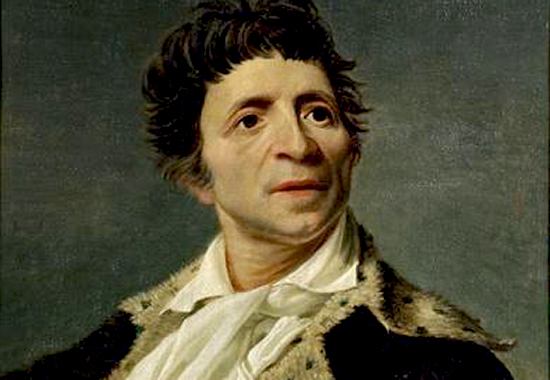
Jean-Paul Marat 1743-1793
Leader
of the Montagnards
Marat was a political extremist,
a republican revolutionary, a radical democrat. He was friends with and champion of the
 sans-culottes.
sans-culottes.
|
|
Image Above
Portrait of the
French politician Jean-Paul Marat
Oil on canvas by
Joseph Boze, 1793
Musée Carnavalet |
Marat was a
 Jacobin, a Montagnard, a
Jacobin, a Montagnard, a
 Cordelier.
Cordelier.
Who Were the Montagnards?
In a nutshell, the Montagnards
were the Jacobin deputies in the National Convention.
The Montagnards, French literally Mountain Men,
was a political group that formed during the
 French Revolution.
French Revolution.
This group of radical revolutionaries
was so named because they were sitting on one of
the higher placed benches in the
 National Convention.
Other deputies that were placed on the floor were called National Convention.
Other deputies that were placed on the floor were called
 the Plain, or La
Plaine, and represented the political centrist majority.
the Plain, or La
Plaine, and represented the political centrist majority.
The Montagnards'
opposition
in the National Convention were the
 Girondins, who were
eventually purged.
Girondins, who were
eventually purged.
See also
 Montagnards in the
French Revolution Glossary.
Montagnards in the
French Revolution Glossary.
Marat in a Nutshell
Jean-Paul Marat was born on May
24, 1743, at Boudry, in today's Switzerland.
Boudry is located between
Besancon and Berne at the Lake Neuchatel.
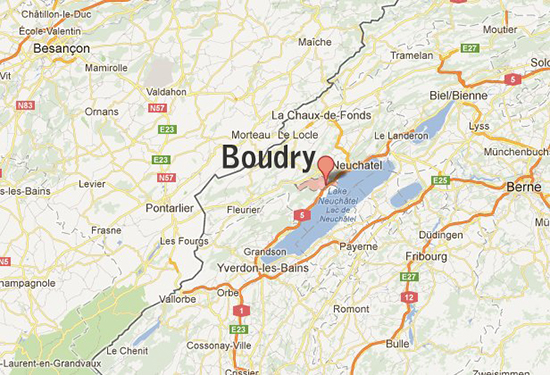
Map Location
of Boudry, Switzerland
Google Map
And back in the days, the map looked like this:
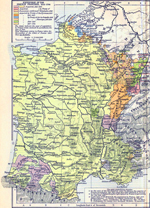
France
1601-1766 Frontiers
Click to enlarge
Marat's father was from Sardinia
and his mother from Geneva. The family lived on a modest
income.
Marat studied philosophy and
medicine. He went to school in Neuchâtel and
later Bordeaux.
In 1762, Marat moved to Paris
where he became a physicist.
In 1765, he
traveled to London where he wrote on medicine, politics, and law.
His writings were translated from English into French.
Back in France in 1777, Marat
became the trusted physician
of the guards serving the
 Comte d'Artois, Louis XVI's
youngest brother.
Comte d'Artois, Louis XVI's
youngest brother.
Although Marat continued his scientific
research, the French Academy of Sciences at Paris
(Académie des sciences) rejected his work. This might or might not have placed an enormous chip on
Marat's shoulder.
Marat and
Politics
In 1780, Marat quit being a
doctor and focused on politics. He became a passionate
political journalist.
In September 1789, Marat created
his own newspaper, the People's Friend (L'Ami du Peuple).
At first in favor of the
monarchy, Marat quickly shifted in his views all the way to the opposite side
of the political scale. He joined the radical
 Jacobins. He
wrote in favor of the
Jacobins. He
wrote in favor of the
 sans-culottes and
violently against the
King of France, against French aristocracy, and against the rich in
general.
sans-culottes and
violently against the
King of France, against French aristocracy, and against the rich in
general.
Marat spoke out against
 Jacques
Necker and, as a consequence, he had to flee to England in early
1790. After three months he came back, became a leader of
the
Jacques
Necker and, as a consequence, he had to flee to England in early
1790. After three months he came back, became a leader of
the
 Cordeliers Club, attacked
Cordeliers Club, attacked
 Lafayette,
Mirabeau,
Bailly, and the émigrés.
Lafayette,
Mirabeau,
Bailly, and the émigrés.
Marat was sentenced to a month
in prison. He went again into hiding (again off to
England), but he never gave up voicing his opinions.
Politically, Marat's big break came in September 1792 when
he was elected
to the
 National Convention as a Paris deputy. He took
his place with
the Montagnards. Now a hardened extremist, Marat renamed his newspaper to
Journal de la République Française, or Journal of the French
Republic. National Convention as a Paris deputy. He took
his place with
the Montagnards. Now a hardened extremist, Marat renamed his newspaper to
Journal de la République Française, or Journal of the French
Republic.
Marat spoke out in support of
the
elimination of enemies of the Republic as a rule. His
was one of the 380 votes, cast on January 19, 1793, that
sealed the decision to execute
 King Louis XVI. With
only 310 against the sentence, the King was executed
two days later.
King Louis XVI. With
only 310 against the sentence, the King was executed
two days later.
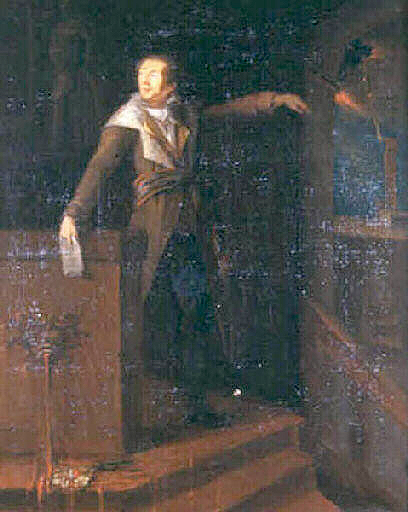
Marat Voting for the Death of Louis XVI
Oil on canvas by Jeanne Dabos
In this painting, Jeanne Dabos turns Marat's
rostrum into a fountain of blood.
Outside it is not less
creepy where lightning strikes over the guillotine.
© Versailles, Musée Lambinet
In April 1793, the Girondins
dragged Marat before the Revolutionary Tribunal. He was
acquitted on April 23, 1793, and came back with a vengeance.
By June 2, 1793, the Girondins
were ousted from the National Convention.
The Death of Jean-Paul Marat
Marie-Anne-Charlotte Corday d'Armont — her
friends called her Marie — was a 24
year-old lady from
Normandy. She was politically connected with the
 Girondins
and held Marat responsible for much
of the Terror. Girondins
and held Marat responsible for much
of the Terror.

Charlotte
Corday
Engraving
Bibliothèque Nationale Paris
Marat suffered from a skin disease and enjoyed long baths
that soothed his condition. He made the best
of it and turned his tub into his office. He wrote in the tub,
he read in the tub, and he received visitors while in the tub.
To Stanford's late Ronald
Hilton's question,
Was there ever a statesman who spent more
time
in the bath than
 Winston Churchill?
Winston Churchill?
We
reply: Perhaps. And as far as we know, Churchill didn't even have a skin condition.
Back to Marat.
Mademoiselle Corday pretended that she was in need of
protection from rival revolutionaries. On July 13, 1793, she was allowed to
speak with Marat, who was in his bathtub.
The two talked for a while and then she stabbed him.
And somehow, this scene became
very popular among painters.

Death of Marat
/ Marat Assassiné
Massive oil on canvas
(165 x 128 cm / 65 x 50 in) by Jacques-Louis David,
himself a Jacobin, painted in 1793 shortly after Marat's
assassination.
This painting is also referred to as the Pietà of the
Revolution.
Royal Museums of Fine
Arts of Belgium
A pieta, by the way, is a
representation, in painting or sculpture, of the Virgin Mary
holding the dead body of Christ on her lap. From Italian
pietà = piety.
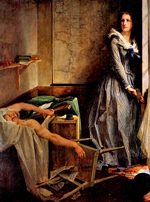
See also
 Assassination of Marat by Charlotte
Corday — painting by Paul Baudry
Assassination of Marat by Charlotte
Corday — painting by Paul Baudry

Charlotte Corday
Wiki
The Legacy of
Charlotte Corday
Charlotte Corday was arrested
the same day, and guillotined on July 17, 1793. However, for her
great courage, she became known as the Joan of Arc of Democracy.
In fact, the entire Corday / Marat
assassination proved to be very inspiring for historians and
artists alike. The lady was compared to
Jael,
Judith, or
Esther (women who saved
their people, see Old Testament).
All in all, it took a pair, she paid for it,
and posterity was somewhat impressed.
Émilie
Dequenne played Charlotte Corday in the 2008
movie of the same name. Bernard
Blancan was Marat.

Charlotte Corday, 2008
The Legacy of
Jean-Paul Marat
In his days, Marat was
celebrated as a martyr for freedom. For his lifetime
achievements, Marat's body was transferred
to the Panthéon, Paris' crypt reserved for outstanding
French citizens.
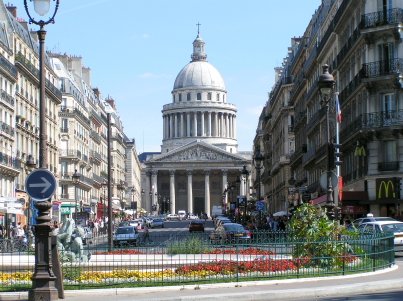
Pantheon,
Paris
French Ministry of
Foreign Affairs
But public opinion shifted, and
after the
 Revolution of 9 Thermidor
(July 27, 1794) his body was removed.
Revolution of 9 Thermidor
(July 27, 1794) his body was removed.
Today, Marat's name evokes the verbal and physical violence of the French
Revolution and stands for the most radical republican views
in France at the time.
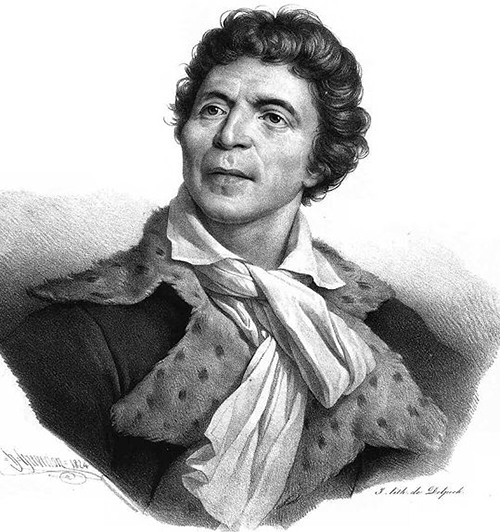
Jean-Paul Marat
Wiki
More History
|